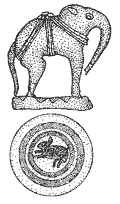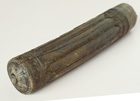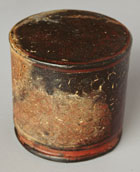|
|
The 'royal seal'
This bronze seal, of a size to be grasped in the fist, has the shape of
an elephant. The seal's impression is a hare inside two concentric rings.
Only royalty and high-ranking officials carried bronze seals in the early
Ming dynasty. Royal seals were given to friendly rulers as evidence of
political affiliation, to scare off aggressors. Deceased Chinese emperors
were buried with their seal to avoid misuse. Ordinary seals were made
of soapstone or jade, and could be resurfaced to change the name. Royal
seals were permanent.
|
|
|
Ivory-handled sword
This solid ivory sword handle was accompanied by a 50cm line of oxide
stain in the sand, assumed to have been from the corroded blade. Few people
could have afforded or been entitled to carry such a delicate sword. It
could have belonged to a high-ranking officer, but the location tells
us that it was not to be used during the voyage.
|
|
|
Imperial lacquer box
Imperial lacquer ware was made from very thin woven bamboo, covered in
hundreds of layers of lacquer, of alternating red and black. Once incised,
the fine layers of red and black can be seen in the cuts. Lacquer products
were made in many places in China, but this type was made only at imperial
factories.
|
|
|
Lu Dong Bin bowl
This bowl shows one of the eight Chinese immortals, Lu Dong Bin, with his
famous sword on the back. Lu Dong Bin was one of two great swordsmen in
Chinese history. According to mythology, he achieved incredible feats -
sexual and otherwise. |
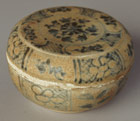 |
Vietnamese covered box
Vietnamese blue-and-white ceramics were scarce in the mid-15th century.
The Royal Nanhai carried two similar covered boxes in the hidden
compartment. Although made in Vietnam, they could have been procured in
Thailand, as the two countries had a close trading relationship. |
Why these valuable objects were together in the hidden compartment is a fascinating
question. We suspect they were royal gifts.
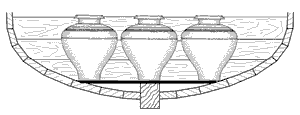 The
protruding keel of the Royal Nanhai was covered with transverse planks,
adding a cargo floor below the main deck. One space next to the keel contained
a number of unusual artefacts. The space could only be reached after offloading
all other cargo, so it may have been the ship's 'safe'.
The
protruding keel of the Royal Nanhai was covered with transverse planks,
adding a cargo floor below the main deck. One space next to the keel contained
a number of unusual artefacts. The space could only be reached after offloading
all other cargo, so it may have been the ship's 'safe'.